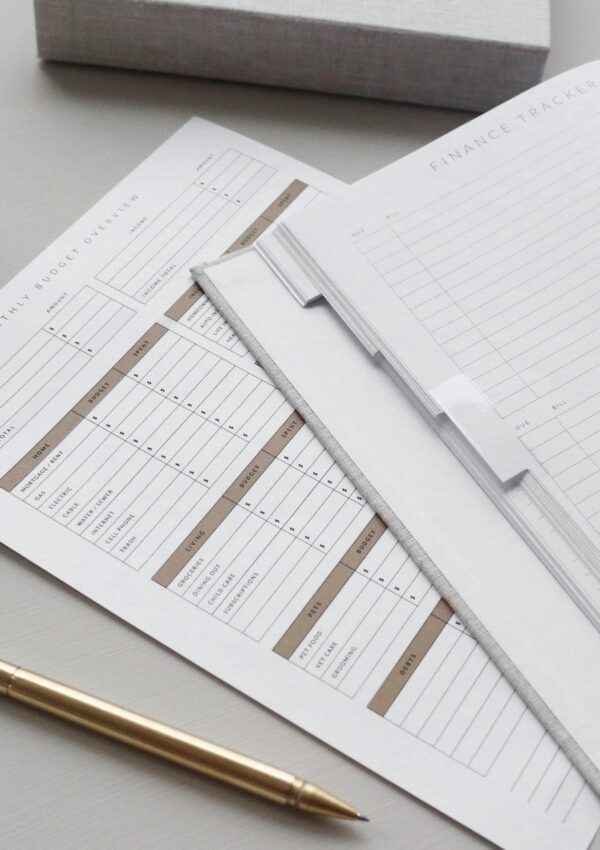My budget story is a short one. It’s interesting seeing the progression, though.
- As a kid, I grew up using the Dave Ramsey envelope system
- In my college years, I just tried to spend the least money possible
- In my early career years, I didn’t really budget, and only made sure I was saving
- Currently, my husband and I budget certain things and focus on a high savings rate
What’s your story?

Envelope System
The Dave Ramsey envelope system is essentially an all-cash budget method.
The idea is to have an envelope with cash for every category of spending for each week or month.
This system works well with spending in physical stores.
With spending online, obviously this system won’t work.
A main reason, I’d say the envelope system is good for teaching kids, but not practical for adults.
The idea of using a cash system is creating a hard stop to spending when a particular category reaches the end of the allotted cash. While you can technically borrow money from another envelope, that would be breaking the rules of the system.
What about Bills Paid Online?
Online bills and autopay can obviously stay put as most companies prefer online payments and it’s far easier. The cash system is more meant for in-store spending that has the potential to go over budget. This includes groceries, gift buying, shopping, etc.
Rollover Cash Bonus
Coming in under budget is a win, win. If you landed under budget in a category, this money can be used to treat yourself to a nice coffee etc., or you can roll it over to the next period and be ahead in that budget.
Benefits of the Envelope System
The envelope system makes physical spending more personal and inconvenient, and as a result, more difficult to overspend in budgeted areas.
The system, used correctly, can knock a person out of the habit of swiping a credit or debit card too much.
Teaching children the basic principles of setting aside money for certain things using envelopes is an easy method to introduce money management to kids.
Downsides of the Envelope System
The biggest downside of this system is obviously the time it takes to get the allotted cash for each category set up each week or month. It is inconvenient to the max. The set up and the payment in stores.
However, if the inconvenience and physical nature of this type of spending will help you swipe plastic less and actually stay on track, it may be the best route early on in budgeting to shock the system into doing something different. Breaking old habits before building new ones, in a sense.
I’d say the main downside is how online our world has become. This system was first introduced to me in the early 2000s. I could see it being more applicable to use on a household scale then. Now, the impact would seem almost too little to make it worth it, with online grocery orders and online shopping being so prevalent.
My Experience
I experienced the envelope system as a way to learn budgeting as a kid. It was very effective to budget all my money at the time, which was birthday and Christmas money.
The concept was easy to grasp and helped set up categories of spending in my mind at an early age.
I started with three main envelopes:
- Save
- Spend
- Give
Later on when I started working my first job, I added a Vehicle envelope and my own Emergency fund envelope.
The envelope system worked hand in hand with what my parents were teaching us financially, which was to save and be generous, and when we did make purchases, to buy things that were useful and intentional. The system created a space for me to feel like I was making decisions about my money at an early age. It introduced habits that mattered at a time when money didn’t. These habits worked to serve me well later in life.
What Budget? All I need to Do is Save, Save, Save
Once I started working and getting more cash flow while in college, I still spent only cash in that time and simply tried to not spend very much.
My approach to money was essentially to save as much as possible and spend the least possible. It was more of a mindset than a budget. While I did track my meager spending every month, it really wasn’t anything to spend too much time doing.
I was so focused on taking as many classes as I could and trying to test out of classes when I was between semesters, that I didn’t have much time to do anything else.
This phase of life was more of a general mindset to money management rather than following a ridgid budgeting system.
I’d argue that a person’s early perspective and relationship with money outflow into a mindset towards money later in life. This mindset can either make or break a young person.
I was fortunate to have parents who intentionally taught me to save and manage money early. This way of thinking about money had already been set in place with the envelope system for years before I started to make more income and have more freedom to spend.
This stage of life involved a mindset that ran in auto pilot based on previously-instilled habits.
First Big Girl Job
After graduating college and starting my first job teaching, I did start to spend more money. This was mainly due to picking up a hobby dancing west coast swing, which involved traveling to events and spending more money than I had ever spent before on travel, food, and fun.
I’d say my mindset of saving most of what I made still served me well, but this period of my life was likely the most free in terms of not tracking every cent. I’m honestly not entirely sure what my percentage of savings was at that time.
I was still saving, but it wasn’t something I recall being very intentional about. I was more focused on learning my new job and having experiences.
It’s worth noting that I was still living at home at this time and only had a few bills, so I was still able to save while traveling frequently.
Overall, my background being taught to be a saver allowed this lackluster method of money management to work well for me. This lasted about 2 years.
Enter the FIRE Movement – Savings Rate Fananza
After two years of teaching, I was certain that path was not for me longterm and moved on.
I ended up job searching for five months before finding a new career in a different city.
Once I started the new job, I acquired more bills, groceries, rent, gas, etc.
At this point, I had been introduced to Mr. Money Mustache and the FIRE movement–Financial Independence Retire Early Movement.
After I saw a retirement table in one of his posts that showed the relationship between savings rate and the years required to work, I soon began shooting for a 75-80% savings rate.
Based on the chart, 75% would mean I could retire in 7 years and 80% meant I could retire in 5.5 years. For the most part, I floated around 58%-65%, but there were some months I did hit 75% savings of my net income.
A Few Things to Note
It’s important to note that while I was saving a high percentage, I was not investing any of my own savings in market index funds that the retirement chart was largely based on.
I had grown up working in the world of real estate with my family, so I was saving to be able to buy a rental cash at the time. I understood real estate better than the market so that was the route I was taking.
It is also worth noting that while I was renting in the new city, I had worked out a house hack deal with an acquaintance of mine to be able to rent a room and bathroom space and pay by the day.
This deal worked well because sometimes I would stay with a friend during the week and I would almost always go back home on the weekends. So, I wasn’t fully paying a monthly rental amount. I was paying 3-4 days a week in rent.
I enjoyed this time and worked hard to be extra on top of what I allowed myself to spend, with the idea of early retirement in mind.
Budgeting as a Couple
Once I got married, the discussion of setting up an actual budget was necessary.
Living with a mindset of save, save, save, and keep a close eye on where my money was going worked well as a single person. However, this free floating mindset that had served me well for all those years suddenly did not work when there was another person in the mix.
We were two separate people coming together with similar mindsets, but we had different goals and desires when it came to where and how much we spent on certain categories.
It’s a case of differing priorities and enjoyments.
To mesh those desires, we had to build a mindset and parameters for the life we now shared.
This process started with understanding each other’s mindsets as single people and understanding as a couple what areas we needed to set parameters around, as well as the areas we needed to allocate more funds to at this stage in our life.
This approach landed us on budgeting a few key categories and leaving the rest to fall where it would.
Things we set up budgets for:
- Travel
- Groceries
- Date night
- Personal spending allowance
- Clothes fund
Things we didn’t budget:
- Utilities
- Insurance
- Gas
- Giving
- Cleaning supplies
- Housing bills, like mortgage, insurance, etc.
Limiting the areas we had the potential to overspend on and leaving the rest was the general idea. For instance, we knew we were never going to overspend buying soap or paper towels and our set bills were already accounted for.
When it came to setting up an amount of freedom with individual spending, the ‘personal allowance’ fund was the answer. It is the space for each of us to have and do whatever we want with that budgeted amount.
To further maximize freedom in the budgeted areas, we also made the decision to drop the full annual amount in each category at the beginning of the year. This allowed us to budget the annual amount freely throughout the year instead of waiting for the weekly amount to accrue over time.
Bottom Line
Overall, we approached this style of budgeting with the collective mindset of saving the highest percentage of income over our set bills as we could. This mindset helped us create enough excess to have a high rate of savings for real estate investments, while allowing us the freedom to spend in the areas we enjoyed based on the budgets we had set up.
This did not happen overnight, but working to get on the same page as a family is worth the work.
The list of budgeted items above have basically stayed the same since, with the exception of a few adjustments. We have run this method for almost 4 years and still find it effective.
Remember, a budget is meant to serve the overall end goal, but it is also meant to give you the freedom to enjoy the things you enjoy along the way.




